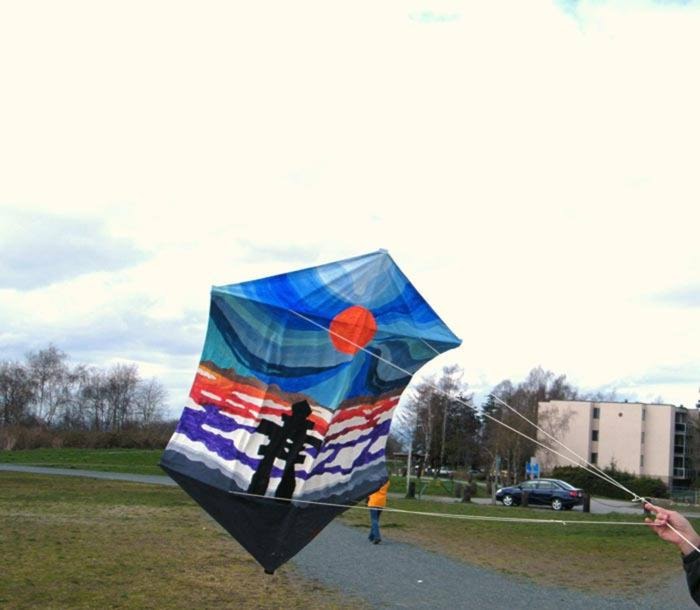A warm, sunny day, with just a hint of a breeze to play with one's hair, is just the perfect day for Dale Pattison, who will often be found on days like this outside, flying one of his kites.
"I find it really relaxing, you go out there and you just fly your kite and you think about nothing," Pattison said. "I just love it, it's my new passion."
Pattison has been flying kites seriously for three years now, but like most it started much sooner: when he was a kid. His father used to take strips of cedar and butcher paper with twine to construct a basic kite. His father, who grew up on the prairies during the depression, would often fly kites for entertainment when he was young, and sought to share that with his children.
"Those were my first experiences flying kites," Pattison said, who noted quite the change with the kites then to the kites of today.
His brother, who has travelled all over the world, got him more involved with flying and designing kites a couple of years ago. When he first started he did fly stunt kites, which are dual-lined and can be controlled more easily by the operator, but their uniformity in both looks and abilities sort of got old fast, he said, who now enjoys the single-lined version.
"The one-lined kites there are so many different shapes and sizes that you can fly," Pattison said.
The stunt kites are also limited as to what images that can be painted on them. Although, to their credit, he once saw a whole troop of stunt flyers who were doing a routine synchronized to music. It must have taken ages, he said, just timing one operators movements, but to do that for all six, he said, just wow.
"They probably practice for hours and hours and hours," Pattison said.
Obviously, that side of the activity has its own followers, Pattison said, who will gladly stick to what he loves: flying single-line, art-rich kites.
"I like it because there's artwork up in the air," Pattison said.
Two years ago he went to China for a kite festival where the skies were just filled with kites. All kinds of shapes, colours, and styles were to be seen (some even heard) with traditional Rokkaku kites (six-sided and framed), box kites, even 3D kites. One, in the shape of a sailor's ship, simply took his breath away, Pattison said.
Many other countries hold kite festivals, Pattison said, however China was special not only because of the 300,000 attendees and participants who came out, but because China was where the kite originated from. They'd make them out of gourds and attach whistles to them; these whistles could be heard for miles, and while there Pattison was pleased to see quite a few of the original design commemorating his pastime's beginning.
"It's sort of a haunting, moaning sound that comes out of these whistles that was supposed to keep the spirits away," Pattison said.
The longest kite at this festival was over four kilometres long, Pattison said. What was interesting was that due to the smog you couldn't see it in its entirety when it was flying. They had to measure it using lasers, Pattison said, to get the whole breadth of the kite.
Pattison placed third in the Chinese festival for his kite design. Featuring ice flows in the background with an inukshuk in the foreground, his Rokkaku was pretty well-liked over in China, who viewed it as a traditional Canadian kite.
He's working on another one to take over this March that he hopes will be as popular. It will also be a Rokkaku, but slightly larger, and will feature four Inuit children flying kites, with ice flows in the background. There's a beauty to ice flows, a pristine-ness to them, that Pattison said he's been drawn to, particularly as he spent 10 years living up north.
"Hopefully, when people see that kite in the air, they'll think 'oh, that person's from Canada,'" Pattison said of his design.
He's always had an artistic flair, he said, going back to school where he'd doodle to some of the leather working pieces he'd make, such as belts. In painting kites he's sort of merging two of his passions, he said, to create a work of art.
Pattison and his wife both moved here just last year to work, Pattison said, who noted that it's winds could leave something more desired. It seems you'd just get a kite up in the air when the pressure would die down and so would the kite, Pattison said. It does get annoying, putting a kite into the air continually, but it does explain why there aren't more people, especially kids, here who fly kites.
"It's not expensive, anybody could fly them," Pattison said.
In China this March he's actually looking forward to hosting a workshop in some elementary schools on how to make a kite. It was something that he'd done on the trip before and one that he found very rewarding.
"I'm really looking forward to going back over there," Pattison said, who just loves sharing a great passion of his with others: enjoying the great outdoors and flying a kite.
